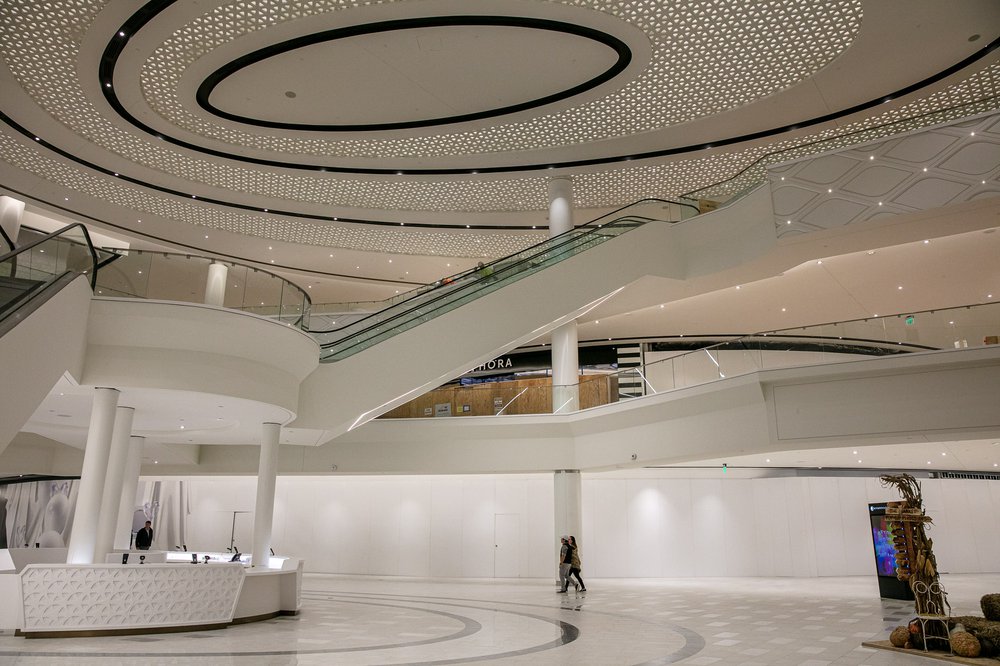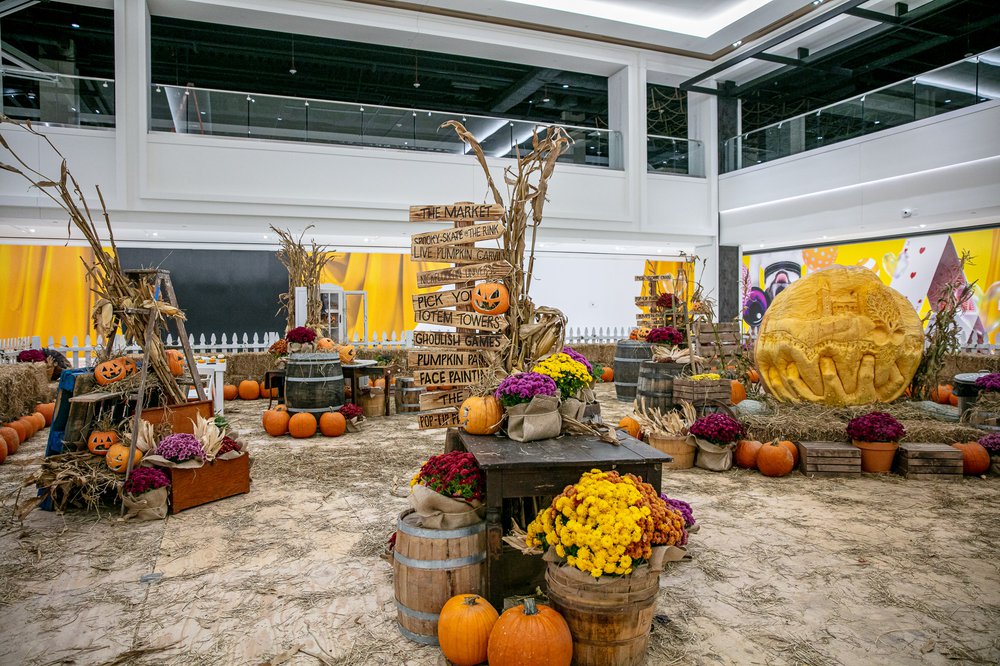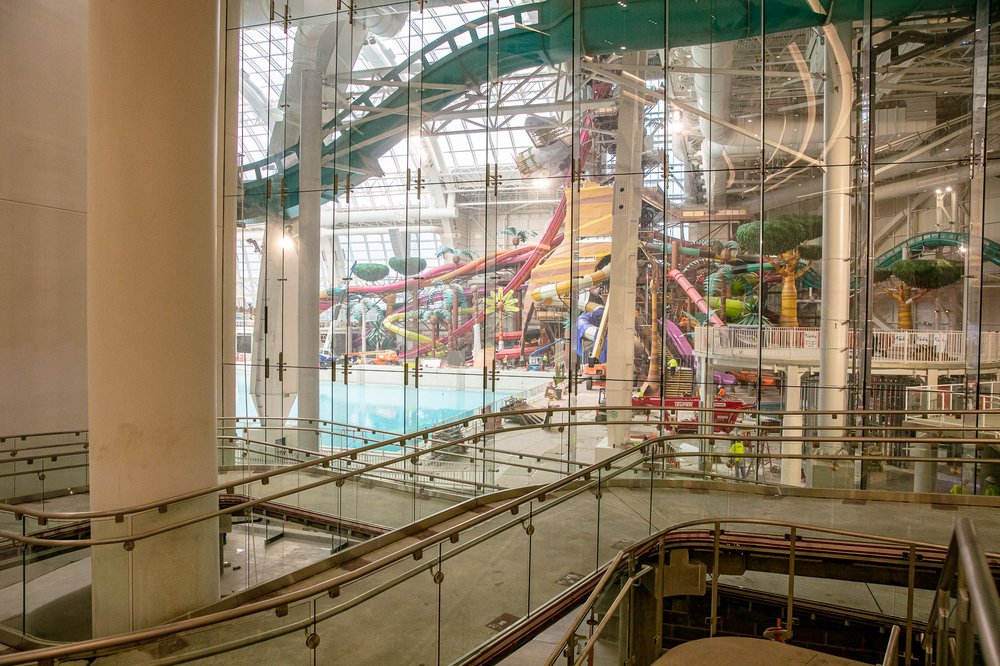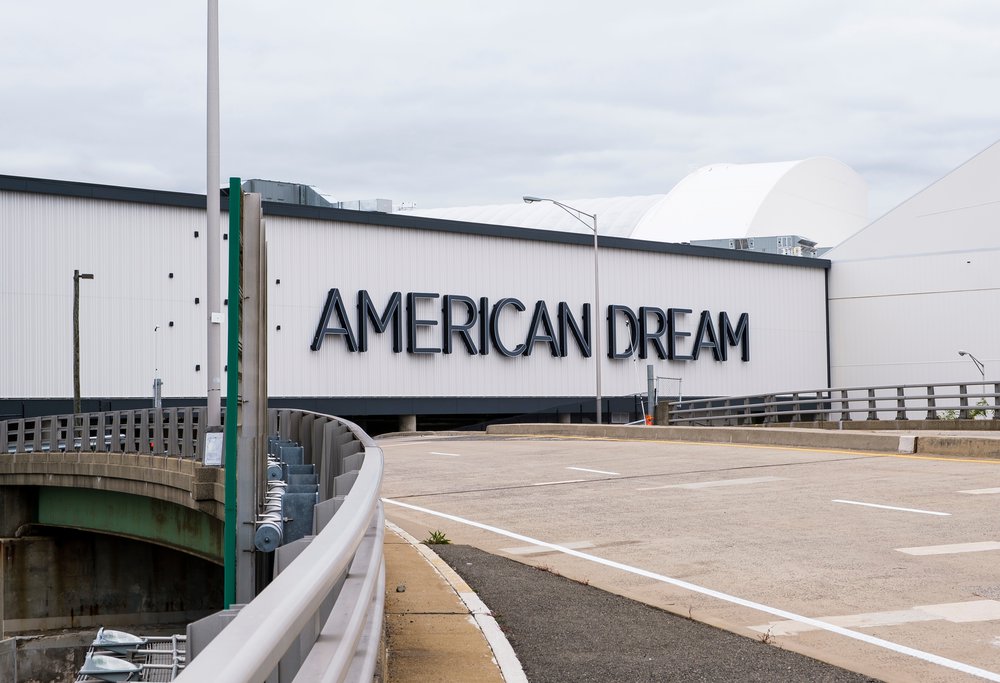Inside American Dream, The Mega-Mall New Jersey Maybe Didn't Need
Nov. 5, 2019, 11:09 a.m.
We spent a day at our local indoor amusement park and managed not to barf.
The first boat to the mall leaves at 9 a.m., and surely you will want to be on that maiden voyage, because you will need time to absorb all the wonders the mall has to offer. This is the second largest mall in the United States, you see, and when completed, it will house within its approximately 3 million square feet an indoor amusement park (allegedly the largest in the Western Hemisphere); a regulation-sized hockey rink; a water park; an aviary; a 16-story ski slope; a “live bunny field”; concert venues; mini golf; Legoland; an aquarium; a luxury movie theater;three helipads; and stores, so many stores. This is the American Dream, and you need only ferry across the Hudson River to attain it.
As interpreted by Canadian real estate firm Triple Five Group, the American Dream means a megamall; a megamall inflated to $5 billion proportions — a “backyard playground” or a “staycation” for Manhattan- and New Jersey-dwellers, as Triple Five chief creative officer Ken Downing put it to CBS. That’s for the set who can shell out $49.99 to ride the rides, and/or $24 (or, possibly, more) to park for the day, and/or $32 for the roundtrip ferry-bus voyage between Manhattan and East Rutherford, New Jersey (there is, admittedly, a cheaper bus route available), and/or however much it will eventually cost to ski down the manmade mall slope, or splash around in the 1.5 acre wading pool. The American Dream has always been an expensive proposition.
It’s also a counterintuitive one, opening a mall at the peak of a retail apocalypse. Between 20 and 25 percent of malls are expected to close in the next five years, as brick-and-mortar stores lose traction to online shopping: Anything you want to buy these days, Jeff Bezos will sell to you at a probable discount, without even asking that you change out of your bathrobe and into real clothes before completing the transaction. The first half of 2019 alone saw about 7,000 store closures nationwide, more closures than occurred in all of 2018. But the long delayed American Dream — previously known as Xanadu, which you will remember as a visual nightmare of squares, before Triple Five stepped in eight years ago — was conceived in 2004's different retail climate, just before the crash of 2008 and just after America’s mall love hit a fever pitch in the 1990s. Although national shopping habits have changed dramatically in the interim, developers still expect an annual crowd of 40 million visitors, hedging their bets on big-ticket experiences: “You don’t need to get in your plane to fly to Orlando anymore,” Don Ghermezian, president of Triple five and the mall’s chief executive, told the NY Times. “You can just come across the river.”
A spokesperson for American Dream wouldn’t tell Gothamist how many people showed up for opening weekend, noting only that a limited number of free admissions were made available between October 25th and 27th. Right now, the public can only access the Nickelodeon Universe theme park and the ice rink; the rest of the attractions will unfold in “chapters." Next comes the DreamWorks waterpark, on November 27th, then the ski slope (“Big Snow”) in December, then, in March, the approximately 450 stores.

It’s unclear why the mall requires so many metamorphoses to achieve its final form, but here are my educated guesses: Each new event presents an opportunity to generate publicity, and in a punishing retail climate, it might prove easier to keep a mall afloat if you cement its reputation as a destination for fun, vacation-style experiences, rather than as another shopping outpost. To that end, hitting the ennuied masses first with the roller coasters, then with skating, then with heated pools in which to pass the winter months, could mean you don’t have to rely on shopping to generate business.
The series of soft openings might be a strategic scheme, or it may be obligatory, because American Dream is currently very far from finished. From the outside, it looks reasonably complete; in fact, it looks like an airport, with a broad, white body that approximates an arrivals hall, and a tall siloed structure from which you could conceivably direct air traffic. A long stretch of sky bridge corrals the MetLife stadium, together with the Meadowlands Arena, into a consumerist compound.

But inside, there’s construction debris everywhere and only a portion of the first floor is available for visitors to roam, making it nearly impossible to fathom the building’s true size. Everything is white, just vast expanses of marble tundra lit by a glowing, perforated ceiling patterned like a giant car speaker. Long empty corridors papered with zany tableaus — watermelon rind owls, ice cream cones dumped on their heads, electrocuted marshmallows, a bubble gum T-rex drowning in Pepto Bismol — stretch into cavernous halls. Here, you may find a ring of moss hills, lousy with overlarge shrooms, rolling through the designated gazebo area. You may find Adirondack chairs scaled for giants, or the occasional scrum of hand-shaped seating, or heaps of hay bales and decorative lettuces and those extra-warty, peanut-skinned pumpkins in celebration of the harvest. (Temporary decorations for the mall’s “fall fest,” an employee tells me.)
At least at present, American Dream looks, as photographer Tod Seelie observed, like a Michaels craft store wandered in and projectile vomited.

It also looks like construction crews have an unreasonably long way to go before they can begin the next “chapter” in the mall’s story. The waterpark appears maybe halfway finished, and escalators to the mall’s top two floors have been blocked off. Our only option for entertainment was the Nickelodeon Universe, but even that’s not all the way open: Faced with about four hours to kill between the designated drop-off and pick-up slots, I resolved to ride all the rides, but of the over-35 options stationed around the football field-sized park, maybe 15 to 20 were operational. These have been divided into two sections: Little Kid Rides, near the entrance, and Big Kid Rides, which you will immediately recognize as being not-for-toddlers because nearly all of them find a way to flip you on your head. Or, as is the case with the nine-tier, Legends of the Hidden Temple-themed ropes course, dizzy you with their towering height.
Park staff, to their absolute credit, were uniformly kind, occasionally even encouraging, about me folding myself into a tiny monster truck wearing a cowboy hat, onto the junior ferris wheel, and inside a spinning teacup on a Rugrats merry-go-round that loudly addresses its passengers as babies. They also exercised extreme patience in the face of technical difficulties, of which there were many. Within a five-minute span, two of the rides I boarded — first the Bikini Bottom Crosstown Express, then Aang’s Air Gliders — abruptly refused to boogie after I’d latched myself under the safety bars, making me feel cursed. These are probably the kinds of kinks all carnivals face a few days in, and American Dream does not appear to be taking any risks: The park’s three rollercoasters, presumably the main attractions, were all closed for testing. This, mercifully, absolved me of the self-imposed obligation to confront the tangle of tracks that occupy the park's entire back wall.

One of these belongs to the Ninja Turtles Shell Raiser, which hauls riders up a ceiling-height vertical incline before vaulting them down, the rail somehow managing to curl under itself before flinging its prisoners through a series of eviscerating loop-de-loops. The other track belongs to the Shredder, purportedly the “world’s tallest and longest spinning rollercoaster.” I don’t know what that one does because they weren’t testing it during my visit, but I can tell you that long wolverine talons jut violently from the cars’ sides as if clawing them apart, and that if the two coasters were running in tandem, they’d likely swoop in and out of one another’s paths, creating the maximally chaotic illusion of an always-imminent crash.
Peak chaos seems like the goal on the more mature side of the park, where I kicked off my nausea tour with Kraang’s Prime Pandemonium, a swinging hammer ride that spins a circle of riders both horizontally and vertically at once. It swoops you all the way up to the ceiling, perilously close to the double-XL fans, suspending you upside down for a long and harrowing moment. It freezes you there until you are absolutely sure your queasy stomach will spill from your mouth, and then plunges you face-first toward the ground. I hobbled off that one and straight onto American Dream’s version of bumper cars (Invader Zim’s Flip & Spin...OF DOOM), which have been reimagined to rotate riders 360-degrees at surprise intervals. Next, I lurched onto Jimmy Neutron’s AtomSmasher, a wheel spoked with uncomfortably humped seats in individual cages that — surprise — spin backward or forward at the rider’s discretion as the whole thing whirls around its circular track.
It was difficult, after hurtling through a series of the Big Kid Rides, to keep down the $12 airport-esque sandwich I broke down and bought around 2 p.m., for lack of any more appealing lunch items. The park’s food options amount to the obligatory offerings you might find at one of LaGuardia’s neglected terminals: bags of chips, sad box salads, wraps liberally stuffed with iceberg lettuce. Although my turkey-and-swiss tasted like the inside of a fridge, I suppose it makes sense to stay away from hot fried foods when you’re planning an indoor amusement park. Being jerked around a funnel cake-smelling hot house by a mechanical arm that cares nothing for delicate human stomachs? A surefire way to make your customers spew.
Still, the specter of barfiness — combined with the chorus of genuinely frightened screams from the handful of office workers and parents who go to theme parks on weekday afternoons — probably means the Nickelodeon Universe has done its job. It’s just unclear whether or not that will be enough to draw the masses back to the mall. Because no matter how many attractions you throw at your visitors, you still need to find people who are willing to spend liberally on regular days at the amusement park. Realistically, who goes to Disneyland more than once a year, at best?

The American Dream mall is located at 1 American Dream Way in East Rutherford.